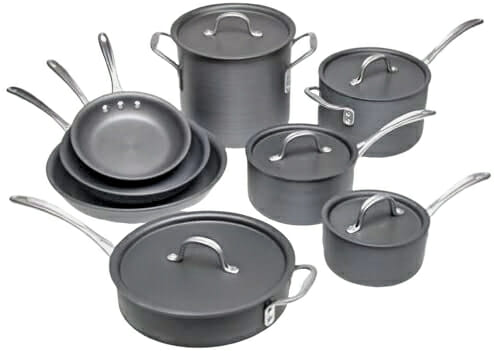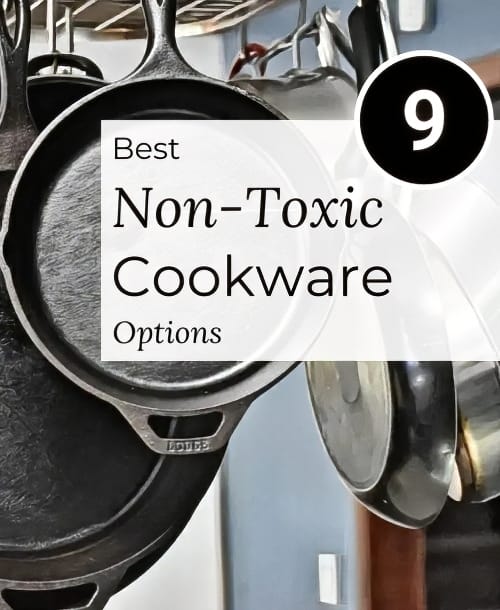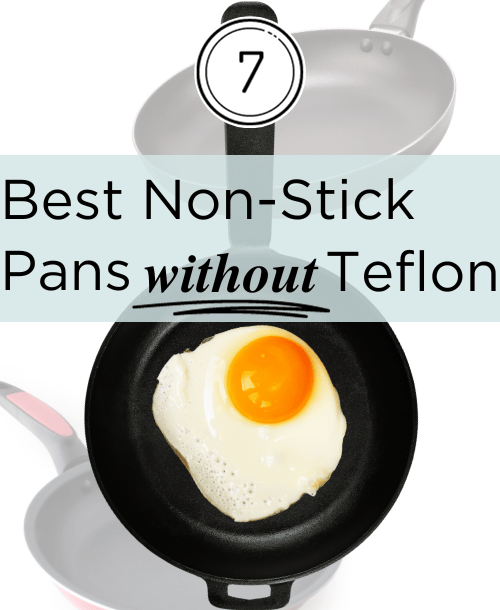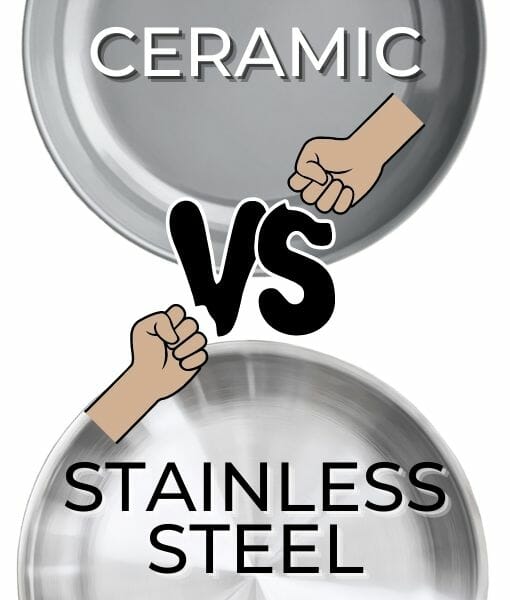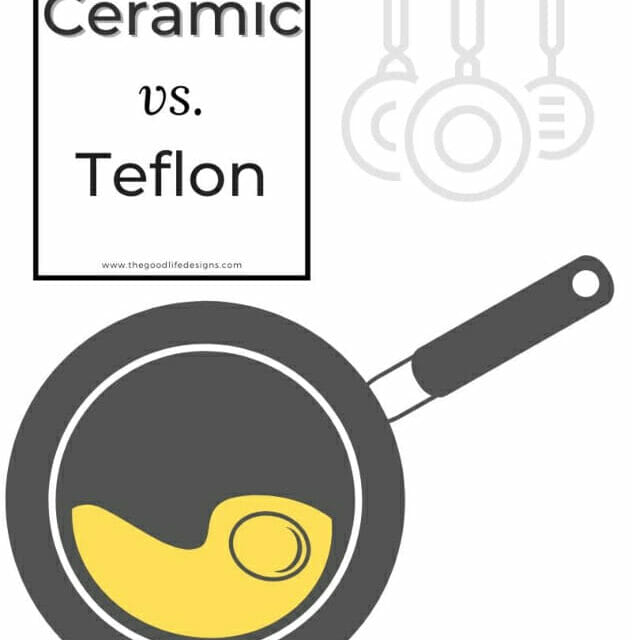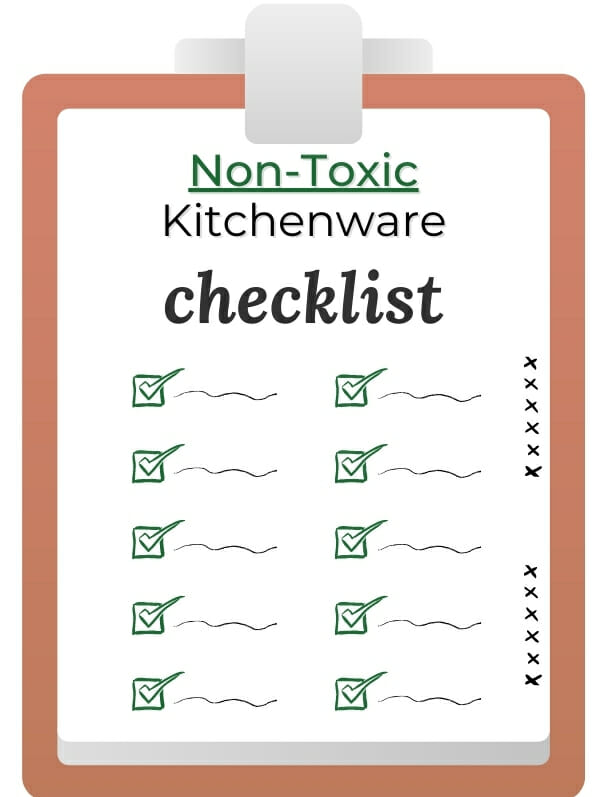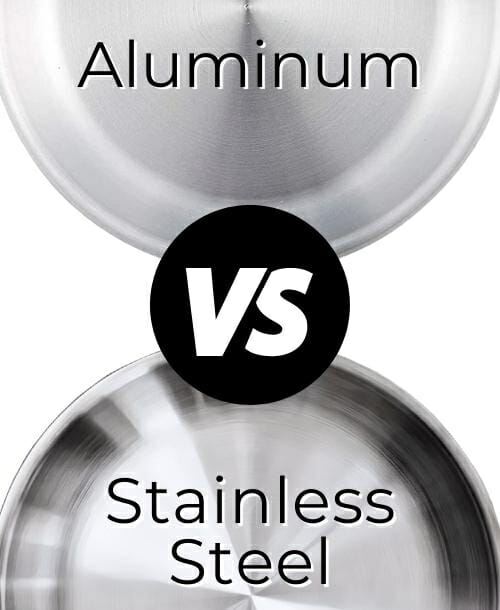
Considering aluminum vs stainless steel cookware, but not sure which to pick? No worries, I’ve got you covered!
We get this question weekly, “Is stainless steel or aluminum cookware better for cooking?”
Followed by, is it safe to cook in aluminum pots? How about stainless steel? What are the health risks, if any?
My answer to all never changes… It depends on what you cook and how you cook it.
This post will compare aluminum and stainless steel cookware— Covering each material’s strengths and weaknesses in the kitchen, including health and safety.
Then, eight crucial factors to consider before you buy, and which material shines for each.
And finally, we’ll bring it home with a summary of who should pick what, my recommended cookware combo, plus the best cookware picks for each material.
Let’s get started!
Aluminum Cookware: What it is, Pros, & Cons
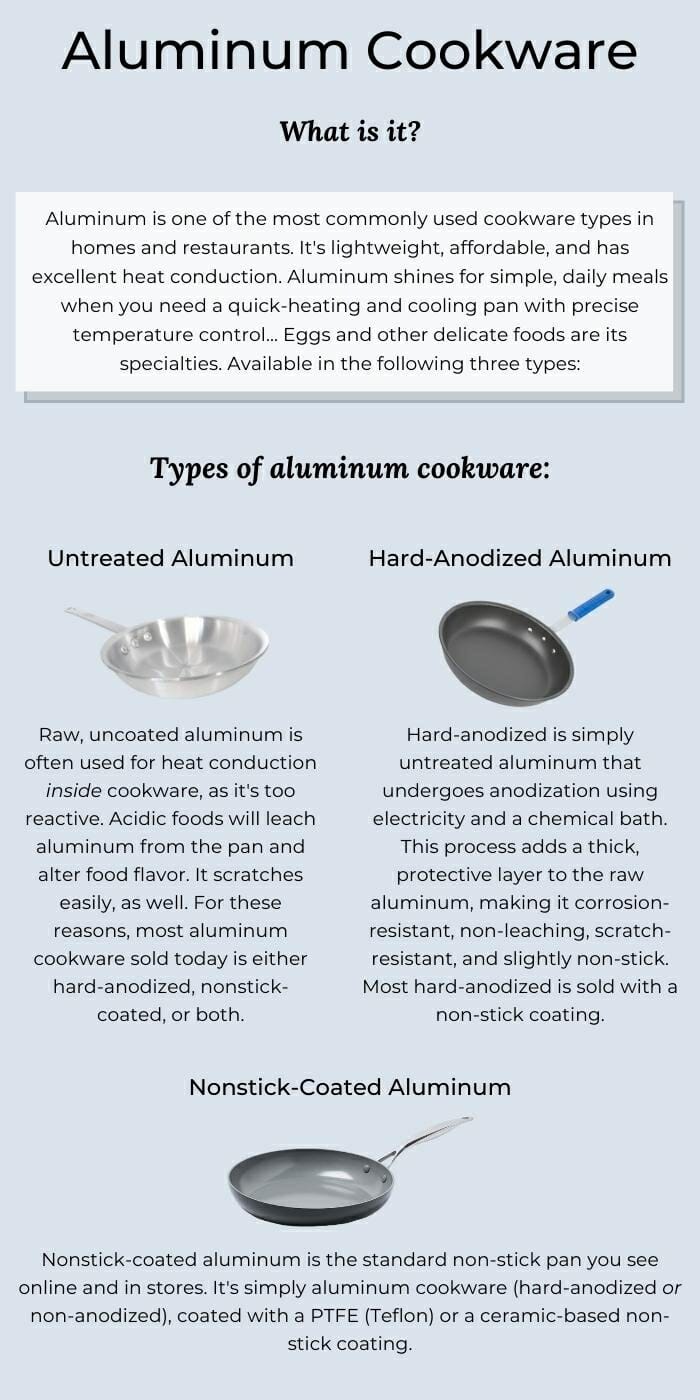
Benefits of Aluminum Cookware
Excellent heat conduction:
It’s not even close when comparing aluminum vs steel for cooking foods quickly and evenly. Why? Aluminum dissipates heat 15x better than stainless, spreading it faster and more freely. This reduces hot spots and allows you to churn out quicker meals with less sticking.
Lightweight:
Aluminum pans weigh ⅓ that of stainless steel (generally). So, maneuvering them while cooking and cleaning demands far less effort. Those with weak wrists or arthritis will find aluminum’s weight extra helpful.
Inexpensive:
Aluminum cooking pots (both hard-anodized & untreated) generally cost less than stainless steel. For example, high-end steel sets can reach $3000+. Yet, top-of-the-line hard-anodized sets rarely (if ever) surpass $1000.
Non-stick & easy to clean (when hard-anodized and/ or nonstick-coated):
Uncoated hard-anodized aluminum has a stick-resistant surface that’s easier to clean than steel. It’s also free from non-stick chemicals. But, nonstick-coated aluminum is the easiest to use and clean, by far. You’re able to cook sticky foods with little to no oil. To learn more, see our list of best nonstick pans.
Durable (when hard-anodized):
Hard-anodized has 3x the strength of untreated aluminum yet weighs the same. It’s able to outlast its untreated counterpart as it’s far more warp and scratch-resistant.
Non-reactive – won’t alter flavor (when hard-anodized &/ or nonstick-coated):
Hard-anodized aluminum does not chemically react with acidic foods. You can cook whatever you want without leaching metallic taste into your meal. But, you must take care not to damage the non-stick coating or anodized layer. Doing so may expose the reactive bare aluminum.
Resists rust & corrosion (when hard-anodized):
Hard-anodized has a thick oxide layer that protects the bare metal from corrosion. The same goes for nonstick-coated aluminum. But, untreated aluminum will corrode from moisture.
Drawbacks of Aluminum Cookware
*Bare aluminum reacts with acidic food (*from untreated aluminum or the exposed core of scratched hard-anodized):
Acidic foods (tomatoes, citrus, onion, etc.) cause bare aluminum to react and leach into your meal. Now, aluminum cookware poses no real health threat unless you have a kidney disorder. But, it can ruin your food’s flavor and cookware’s appearance.
Not induction-compatible:
Induction stoves need magnetic metals to work. By itself, aluminum has virtually zero magnetism. So, it won’t work on induction stoves unless the pan has a magnetized base (like this one).
Cannot use high heat or the oven – limited to medium heat:
Aluminum melts at a relatively low temperature of 1,221℉, losing half its strength by 600℉. Too much heat can weaken, discolor, and warp aluminum cookware, including hard-anodized. Nonstick-coated aluminum has the most heat limitations… Once you exceed 464℉, it can off-gas harmful fumes.
Not dishwasher-safe:
High heat, water, and harsh chemicals will corrode untreated aluminum. It’ll also ruin non-stick coatings. As for uncoated hard-anodized pans, moisture can bypass the anodized layer and corrode underneath if scratched.
Can’t use metal utensils:
Metal utensils scratch untreated aluminum pretty easily and destroy non-stick coatings. Uncoated hard-anodized better withstands metal, but deep scratches can expose the reactive aluminum. Use wood or silicone utensils only.
Poor browning & searing:
Aluminum is not good for cooking at high temperatures as it cannot hold heat well. For example, when you drop cold food on a hot aluminum frying pan, the pan cools too much for a proper sear.
Stainless Steel Cookware: What it is, Pros, & Cons
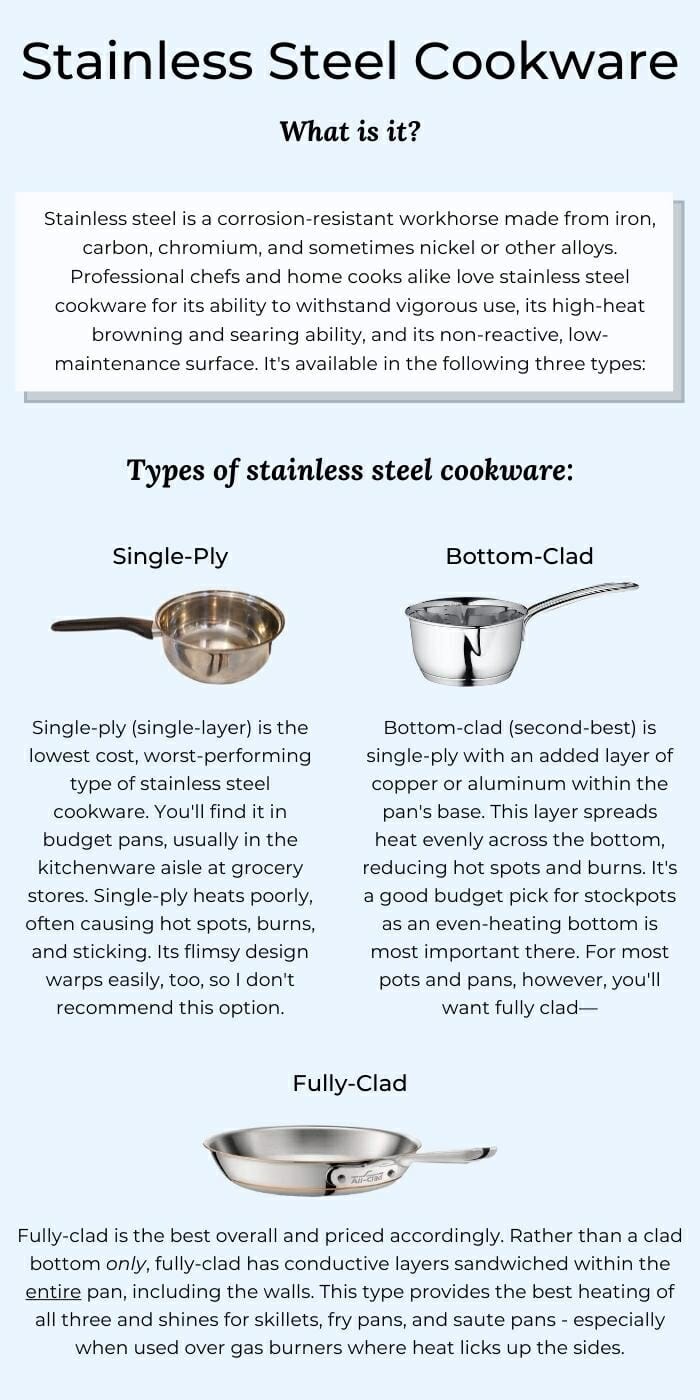
Benefits of Stainless Steel Cookware
Great for high-heat cooking, searing, & browning:
Stainless steel has 3x the density of aluminum. So although it takes longer to heat, once it gets hot, it stays hot. When you drop cold food onto hot steel, the temperature doesn’t fluctuate as much as aluminum. So, food sears and browns like a dream.
Durable, metal utensil-safe cooking surface:
Due to its higher density, stainless steel resists damage to its surface better than aluminum… There’s no anodized layer or coating to worry about, either. So, you can use metal utensils (gently). For stuck-on food, you can get away with abrasive cleaners here and there without terminal damage.
Non-reactive & corrosion-resistant:
Stainless steel does not chemically react with acidic foods. So, food flavor never changes, regardless of ingredients! It shines for anything from hearty steaks to acidic tomato or lemon dishes.
Oven-safe (dependent upon lids & handles):
You can safely braise and broil food at high temperatures with stainless steel. Unlike aluminum, stainless doesn’t weaken until 900-1200℉ (instead of 600℉). So, it’s far more able to withstand frequent oven use and thermal shock without damage.
Attractive:
Stainless steel’s sleek, stylish finish looks great in any kitchen, regardless of decor. So you’ll never have a problem matching it to your home.
Dishwasher-safe:
Have to work late some nights? Don’t want to deal with scrubbing pans afterward? With stainless steel, you can get away with a dishwasher cycle here and there (with mild detergent). But, hand-wash most of the time to maintain stainless steel’s shine.
Works on all stovetops, including induction:
Most stainless steel cookware works on induction. But, always check for the “induction-ready” badge as higher nickel steel (18/8, 18/10) has weak magnetism. Induction-ready cookware often has a 400-series stainless steel disk on the bottom. 400-series contains lower nickel, boosting induction performance.
Drawbacks of Stainless Steel Cookware
Food sticks easier, harder to clean:
Cooking delicate foods without sticking proves challenging with stainless steel. Even non-sticky foods can stick without proper heating and oiling. Now, it’s relatively easy to prevent sticking with stainless steel, but it takes more effort than aluminum.
Can be expensive:
One of the main disadvantages of stainless steel is its high upfront cost. Now, you can find inexpensive stainless steel cookware sets, but they’re likely single-ply or bottom-clad. Fully-clad has a higher price, yet a good set can easily last a lifetime, making for an intelligent investment.
Can stain or lose its polish:
Stainless steel can discolor from hard water (calcium), burning food, and chlorine-based detergents. But it’s easy to prevent… Use mild detergent and avoid using too much heat. To rid stains, follow these simple tips.
Poor heat conduction (if no conductive layers):
Comparing heat conduction in aluminum vs stainless steel pots, aluminum wins by a landslide… That’s why I’m pushing fully-clad stainless steel cookware with an aluminum core. Non-clad, single-ply steel will cause nothing but hot spots, burning, sticking, and frustration.
Can feel heavy to some:
Although not as heavy as cast iron, stainless steel weighs about 3x more than aluminum. Add in 3, 5, or 7-layer cladding; the weight rises even more. But remember, steel’s density helps it hold heat and sear food better.
Can leach nickel & chromium into acidic food (mainly when scratched):
Studies using tomato sauce show acidic foods can absorb nickel and chromium. Now, it’s unlikely you’ll ever consume enough to impact health… But, those with nickel sensitivities may experience dermatitis. Steel cookware with deep scratches leaches most abundantly.
8 Decision-Making Factors to Consider Before You Pick
…& the winning cookware material for each:
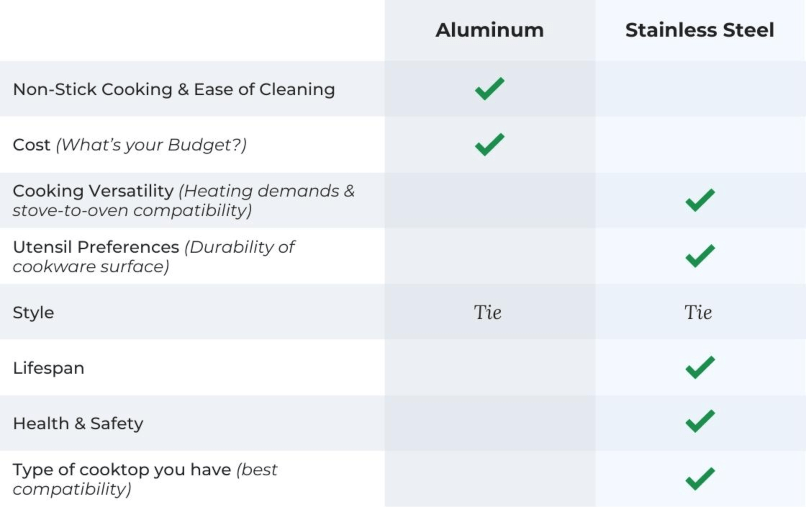
We’ve compared aluminum and stainless steel cookware by their pros and cons. So now, let’s look over eight factors that are critical for your decision.
For each factor below, we’ll do a quick recap and give the winning material in that area of performance. This comparison will combine and clarify the above information, helping you inch closer to the right choice.
Non-stick cooking & ease of cleaning:
Nothing’s easier to use than nonstick-coated aluminum (either Teflon or ceramic-coated). You’re able to cook sticky eggs with little to no oil, reducing calories. Afterward, it wipes clean in seconds. The second-easiest? Uncoated, hard-anodized. It’s stick-resistant without non-stick chemicals, like carbon steel and cast iron.
Cost – What’s your budget?
Cost varies depending on the brand itself. But, generally speaking, hard-anodized sets are far more budget-friendly. You’ll find high-end sets of hard-anodized for much lower prices than high-end stainless.
Cooking versatility (Heating demands & stove-to-oven compatibility):
Aluminum shines at fast, even heating, and quick stovetop meals – especially sticky breakfast foods. Yet, you can sear, brown, broil, and oven braise at high heat with stainless steel. And with a few tips, cook eggs without sticking. Fully-clad steel pans combine the strengths of both metals.
Utensil preferences – Durability of cookware surface:
Stainless steel is far more rugged. Its surface has 2-3x the hardness of aluminum, making it less prone to scratching. Plus, there’s no coating, only steel, so it safely withstands metal utensils. Yet, metal can scratch hard-anodized pans, exposing the reactive bare aluminum. And metal obliterates non-stick coatings.
Style:
This one depends on your preference, but stainless steel has more of a “universal” appeal… Its stylish yet neutral appearance compliments any kitchen. Yet, hard-anodized sets come in many color options, allowing you to match your decor.
Lifespan:
Well-made, uncoated hard-anodized can last many years if properly cared for. But, without proper care, you can lose the protective layer or warp the pan. Nonstick-coated aluminum has a shorter lifespan – 3-5 years, tops. Yet, quality stainless steel cookware often lasts for life.
Health & Safety:
So, is stainless steel or aluminum cookware better for health? Well, it depends on the person. Although the medical community considers both metals safe, they can leach some material into food over time. For most people, there’s nothing to worry about (as long as you’re not allergic or have kidney problems). But, recent studies show excess aluminum can damage bone cells. Yet, nickel and chromium (stainless steel) show no impacts on bone health.
Type of cooktop you have (compatibility):
Both aluminum and stainless steel work well on gas and electric stoves. But for induction, pick stainless, as most aluminum pots and pans aren’t compatible.
Next, let’s bring everything together with a summary of all the key points. Then, our recommended cookware picks.
Aluminum vs Stainless Steel Cookware – Summary: Who Should Pick What
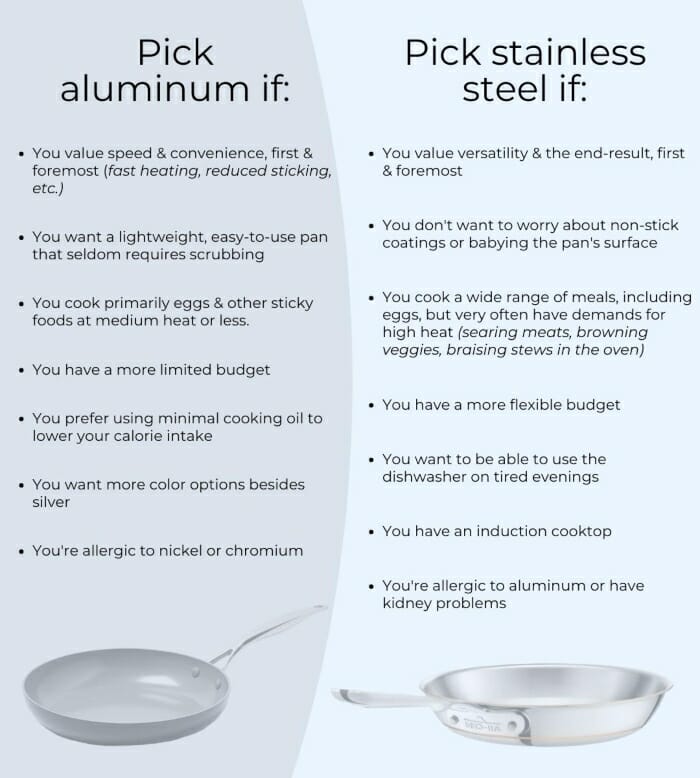
My Favorite Cookware Combo & Top-Rated Picks
Aluminum pots vs stainless steel isn’t really a competition. There’s no winner, per se.
Each has its unique purpose; its strengths. That’s why I don’t recommend buying entire cookware sets of one or the other.
Instead, I recommend a healthy mix of aluminum and stainless steel cookware for any well-rounded kitchen… For the same reason builders use both hammers and screw guns.
Both have the same purpose— to join materials together. Yet, they get the job done a little differently.
A hammer hammers a nail. A screw gun, screws a screw. Whichever you use depends on the job.
The same goes for aluminum and stainless steel cookware… Both have the same purpose— to cook food.
Yet, both do it a little differently. Depending on what you cook, you’ll need a different tool for the job. That’s why I recommend getting both, and here’s the combo I suggest—
Here’s a great starting point & the combo I always recommend:
- Get a fully-clad stainless steel frying pan as your primary workhorse (3-ply or 5-ply). It combines the best of both worlds – steel’s versatility and resilience with aluminum’s fast, even heating. Use it for most meals, especially those demanding high heat. Ideally, you’d get a fully-clad sauté pan as well.
- Bottom-clad stainless steel works fine for stock pots and saucepans if your budget does not permit fully-clad. When it comes to aluminum vs stainless steel stock pots, the pot’s base is the primary focus here, as you want water to heat and boil evenly from the bottom. Although I recommend fully-clad for all pans, you can save a few bucks here with bottom-clad.
- Lastly, grab a hard-anodized, ceramic-coated aluminum pan for the stickiest foods like eggs and pancakes. I don’t recommend PTFE-coated (Teflon) aluminum pans for reasons covered in our ultimate cookware guide.
This combo ensures you have the right tool for each meal. And, as an added benefit, you’ll save money and avoid disappointment—
By building your collection piece by piece, you can see if you like stainless steel or aluminum pans better.
Then, further invest in your favorite. (As opposed to purchasing an entire 12-piece bundle of one type, realizing months later you despise it!)
Top Pick for Stainless Steel

All Clad’s 5-ply pans consist of a rugged 18/10 (316-grade) stainless steel exterior, with alternating aluminum and steel layers inside.
The double aluminum cladding stretches entirely up the sides, producing rapid, even heating. This design prevents hot spots and, as a result, food cooks evenly while limiting burns.
Then, unlike triple-ply pans, a central core of stainless steel separates the aluminum. This core strengthens the pan, offering better defense against warping than tri-ply. In other words, 5-ply is much more forgiving.
Also, the 18/10 stainless steel prevents corrosion better than 18/8, perfect for salty foods.
Altogether, this pan is the perfect kitchen workhorse… It cooks a large variety of foods with excellent results.
- 5-ply bonded construction (steel, aluminum, steel, aluminum, steel).
- Compatible with all cooktops, including induction, thanks to its *magnetic-optimized base. (*Contains lower-nickel steel with higher magnetism).
- Brushed finish that’s easy to maintain and prevents fingerprints.
- Oven and broiler-safe to 600℉.
- Available in 8, 10, and 12” sizes.
- Handmade in the USA.
- Lifetime warranty.
Lower-priced alternatives:
Top Pick for Hard-Anodized Aluminum With Non-Stick Coating
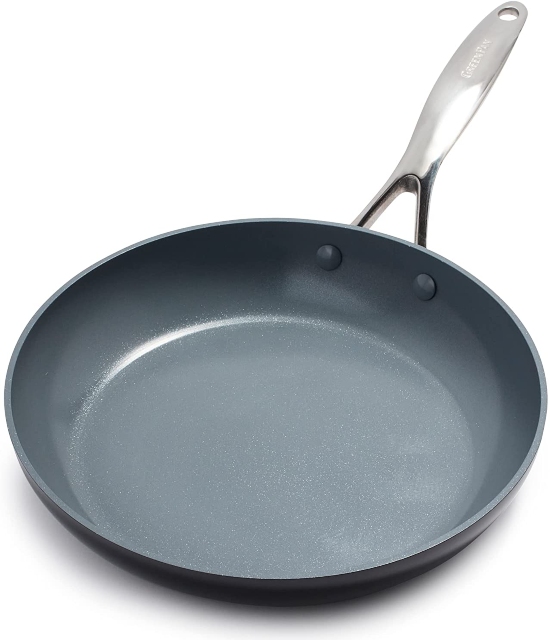
GreenPan’s Valencia Pro features a unique diamond-infused ceramic coating instead of PTFE.
You’ll enjoy the same easy cooking and cleaning that Teflon provides… Yet, if you accidentally overheat the pan, it will not emit harmful fumes like Teflon can! Check out this guide for non-stick pans without Teflon to learn more about this healthy cookware.
And unlike most similar pans, the Valencia Pro works on all cooktops, including induction.
- Hard-anodized aluminum, coated with Thermolon (diamond-reinforced non-stick ceramic). 100% PTFE-free.
- Teflon-like ease, without toxic fumes if you overheat.
- Magneto base (iron/ copper) for enhanced durability, heat retention, responsiveness, and induction compatibility.
- Extra-thick aluminum base resists warping better than similar pans.
- Lifetime warranty.
Lower-priced alternatives:
Top Pick for Hard-Anodized Aluminum Without Non-Stick Coating
Think of this cookware set as a happy medium between the above two—
Like All-Clad’s D5 (and unlike GreenPan), there’s no coating to worry about scratching or chipping.
Yet, these pans resist sticking better than All-Clad, thanks to their slick hard-anodized surfaces.
So if you’re looking for a hybrid between stainless steel and non-stick, grab commercial hard-anodized.
- Commercial, heavy-gauge hard-anodized aluminum.
- Durable, stick-resistant surface, free from artificial non-stick coatings.
- Stay-cool stainless steel handles.
- 13-piece set includes three skillets (8, 10, & 12”), three covered saucepans (1 ½, 2 ½, & 4 ½-quart), a 3-quart covered sauté pan, and an 8-quart covered stockpot.
- A unique 12” Everyday Pan is also available in this same build – get it here separately.
- Lifetime warranty.
Other options available (single pan):
Uncoated hard-anodized cookware is scarce nowadays, hence why I featured a complete set here. Unfortunately, we don’t have many other choices, except for one—
Check out this single skillet from the Webstaurant Store. This shop primarily serves commercial kitchens, but you can find some great cookware for yourself.
Conclusion | Recap for Aluminum vs Stainless Steel Pans
So which is better cookware, aluminum or stainless steel?
Here’s the answer—
Both, depending on what you’re cooking… Each has its specific place and purpose in the kitchen.
But if I had to pick only one, I would get a fully-clad steel pan as it’s far more versatile. You can even use it as a non-stick pan with a little practice. Here’s proof!
To wrap up, here are the key guidelines for anodized aluminum vs stainless steel cookware:
- Get a fully-clad stainless steel pan and a hard-anodized pan (with or without a non-stick coating).
- Use hard-anodized for all your fast-cooking, delicate meals. Things like eggs, french toast, pancakes, seafood, crepes, frittatas, etc.
- Use the stainless steel pan for meat and poultry, browning veggies, sauteing, making pan sauces, and any other higher-heat demands.
- When it comes to cookware besides pans, like stock pots, you can get away with bottom clad stainless steel.
Happy Cookin’
P.S. You’re not limited to choosing stainless steel or aluminum pans only…
Five other types exist, some of which may fit you better than these two! Check them out in our ultimate non-toxic cookware guide.

Hi there! I'm Adam, author and founder of TGL. Since 2016, I've produced and sold non-toxic kitchenware throughout the US. Today, I'm using my passion and experience in sustainable product manufacturing to help families avoid unsafe reusable foodware. When I'm not writing, you'll find me hiking or camping throughout Appalachia!
Enjoyed this post? Share it with your friends!
Related Posts
FREE Guide
Non-Toxic Kitchenware Checklist
Get a step-by-step product guide with insider tips & tricks for the safest kitchen possible!

